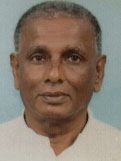Related Research Articles

Frederick Theodore Badcock was a New Zealand first-class and Test cricketer. Perhaps the best all-rounder in New Zealand in the inter-war period, he played seven Test matches for New Zealand between 1930 and 1933, including New Zealand's inaugural Test in 1930. He was the first players capped by New Zealand.
Michael Hugh Tissera is a former Sri Lankan cricketer who played in the 1975 Cricket World Cup.
Cricket was introduced to Sri Lanka in the first quarter of the 19th century, following colonisation of the island by the British. The earliest known match was recorded in 1832 and the earliest first-class one in 1926. The national team has played Test cricket from 1982. The national team has achieved international success by winning the 1996 Cricket World Cup and the 2014 ICC World Twenty20. Cricket is played nationwide with Test venues in Colombo, Galle, Kandy and Moratuwa. The country's most notable players include Aravinda de Silva, Arjuna Ranatunga, Rangana Herath, Sanath Jayasuriya, Mahela Jayawardene, Muttiah Muralitharan, Kumar Sangakkara and Chaminda Vaas. Administration and governance are performed by Sri Lanka Cricket, which was founded in July 1922 as the Ceylon Cricket Association (CCA). The main domestic competition is the Premier Trophy which attained first-class status in 1988.
An Australian cricket team toured Ceylon and India in 1935–36, playing 17 first-class matches between October 1935 and February 1936, including four unofficial Tests.

An English cricket team led by Lord Hawke toured Ceylon and India in the Indian season of 1892–93. It was the second visit by an English team to India, after G. F. Vernon's XI in 1889–90, and the third to Ceylon.
The M. J. Gopalan Trophy was an annual first-class cricket competition played between Ceylon and Madras between 1952–53 and 2007–08.
This article describes the history of cricket in British India from the 1918–19 season until the end of the Second World War in 1945.
Dr Churchill Hector Gunasekara was a Ceylonese first-class cricketer. He was the first person from his country to play for an English county, representing Middlesex from 1919 to 1922. He was widely regarded as the best fielder in county cricket at the time.

Charles Edward Manoharan "Mano" Ponniah is a Sri Lankan architect and engineer who played first-class cricket in Sri Lanka and England from 1964 to 1969.
The Ceylon cricket team toured India in December 1964 and January 1965. Ceylon did not then have Test status, but three four-day unofficial Tests were played, India winning 2–1. The tour also included five other first-class matches.
Anurudda "Anura" Polonowita is a former cricketer who played for Ceylon from 1960 to 1969. He later became a prominent cricket administrator and groundsman. In September 2018, he was one of 49 former Sri Lankan cricketers felicitated by Sri Lanka Cricket, to honour them for their services before Sri Lanka became a full member of the International Cricket Council (ICC).
Ladislaus Edmund "Laddie" Bakelman was a cricketer who played on Ceylon's first tour in 1932–33.
Sagaradaththa Sudirikku "Sargo" Jayawickreme MBE, also spelled Jayawickrema was a cricketer who represented Ceylon in first-class cricket from 1932 to 1950, captaining the team in the 1940s.
The Ceylon cricket team visited India in December 1940 and January 1941. Ceylon did not then have Test status, but two three-day unofficial Tests were played: the first was drawn, and India won the second. The tour also included one other first-class match and two minor matches.
Edward George Samuel Kelaart was a Ceylonese cricketer who played first-class cricket between 1926 and 1935. He was Ceylon's first international captain, leading the side in two matches against India in 1932-33.
The Ceylon cricket team toured Pakistan in March and April 1950. Ceylon did not then have Test status, but two four-day unofficial Tests were played, Pakistan winning both by large margins. The tour also included three other first-class matches and a minor match.
L. D. S. "Chippy" Gunasekara was a cricketer and lawyer who played first-class cricket for Ceylon from 1929 to 1935.
Vernon C. Schokman was a cricketer who played first-class cricket for Ceylon from 1929 to 1935.
Claude van der Straaten, also spelt Vanderstaaten and Vanderstraaten was a cricketer who played on Ceylon's first tour in 1932–33.
Hilton Poulier was a cricketer who played on Ceylon's first tour in 1932–33.
References
- 1 2 I. M. Mansukhani, "Ceylon Tour in India", The Cricketer , Spring Annual, 1933, p. 74.
- ↑ S. S. Perera, The Janashakthi Book of Sri Lanka Cricket (1832–1996), Janashakthi Insurance, Colombo, 1999, pp. 170-71.
- ↑ "Sind v Ceylon 1932-33". CricketArchive. Retrieved 14 September 2017.
- ↑ "India v Ceylon, Lahore 1932-33". CricketArchive. Retrieved 14 September 2017.
- ↑ "Patiala v Ceylon, 1932-33". CricketArchive. Retrieved 14 September 2017.
- ↑ "India v Ceylon, Delhi 1932-33". CricketArchive. Retrieved 14 September 2017.
- ↑ "Central Provinces and Berar v Ceylon, 1932-33". CricketArchive. Retrieved 16 September 2017.
- ↑ "Madras v Ceylon, 1932-33". CricketArchive. Retrieved 16 September 2017.
- ↑ "Test Cricket Tours - India to England 1932". Test Cricket Tours. Retrieved 16 September 2017.
- ↑ "First-class batting and fielding for Ceylon". CricketArchive. Retrieved 16 September 2017.
- ↑ "First-class bowling for Ceylon". CricketArchive. Retrieved 16 September 2017.